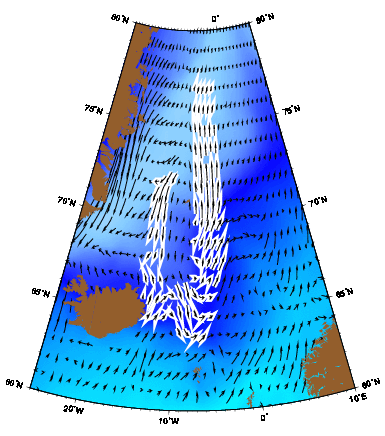
| ||
| The East Iceland Current as represented by the Mariano Global Surface Velocity Analysis (MGSVA). The East Iceland Current brings cold water south from the Norwegian Sea towards Iceland and then eastward, along the Arctic Circle. The flow bifurcates, with one branch going north and one branch going east. Click here for example plots of seasonal averages. | ||
Once it leaves the coast of Iceland, the EIC remains bathymetrically steered as it flows along the northern side of the Iceland-Faeroe Ridge (IFR) (Hopkins 1991). However, the IFR probably does not directly cause the EIC to turn eastward because the current is less than 300 m deep, while the IFR is fully defined at a depth of 500 m. Only one third of the ridge has depths less than 350 m. Hopkins (1991) provides another explanation for the separation: a density gradient that re-directs the geostrophic flow. The mechanism is as follows: the Norwegian Irminger Current carries Irminger Atlantic Water to the southwest coast of Iceland. The Irminger Current transports it clockwise to the northern coast of Iceland, where it cools and freshens as it mixes with Arctic and Polar waters, forming the EIC. The EIC continues to follow the coast of Iceland until it reaches its easternmost point, where the current re-encounters North Atlantic Water. However, because the EIC is much colder, it is also denser than the North Atlantic water. The resulting north-south density difference directs the flow offshore and eastward (Hopkins 1991). The Iceland-Faeroe ridge, which extends from Iceland to the Faeroe Islands, forms a physical barrier that limits the mixing of the fresh, cold (1.8-8°C) waters off Iceland and the salty, warm (4-11°C) waters of the North Atlantic (Griffiths 1995; Malmberg and Kristmannsson 1992; Kalvas and Kautsky 1998). The Iceland-Faeroe front itself also prevents the exchange of these waters (Griffiths 1995).
The ice cover often found throughout much of the East Icelandic Current makes it difficult for researchers to deploy drifters in the area (Poulain et al. 1996). Therefore, estimates of the current's speed and transport are scarce. One estimate comes from Stefansson (1962), who studied the current off the northwest and northeast coasts of Iceland. Using the 1°C isotherm to represent the EIC, Stefansson obtained a transport of 0.64 Sv off Kogur to the northwest and a transport of 1.03 Sv off Sletta to the northeast. Stefansson also found that variations in the east were directly correlated with variations in the west, and that the differences between the two sections were mostly constant. A comparison of flow speeds obtained from dynamic height computations with those measured by drift bottles and water mass tracking resulted in an average flow speed of about 6 cm s-1 (Stefansson 1962; Hopkins 1991).
The formation of surface sea ice depends on the salinity of the upper 100 m of the water column. If this layer has a salinity less than S=34.7, ice can form because the water is not dense enough to convect. A salinity greater than S=34.8, on the other hand, allows convection with enough heat flux to keep the surface free of ice. Thus, the ice coverage north of Iceland depends on the salinity of the EIC, which in turn depends on the eastward transport of Greenland Polar Water by the East Greenland Current and the northward transport of Irminger Atlantic Water by the North Irminger Current (Hopkins 1991). The East Icelandic Current varies not only in its ice cover, but also in the coherence of its flow. According to Stefansson (1962), the core of the EIC mostly followed the shelf break and extended down to at least that depth (about 200 m). However, because the Icelandic coast is quite irregular, the current does not always flow smoothly; there are southward and northward excursions that are consistent with the shelf bathymetry (Hopkins 1991).
The East Icelandic Current itself causes variability in the surrounding waters. According to Blindheim et al. (2000), the EIC may be more important than previously thought in creating variability in the water masses in the Nordic Seas. The EIC may affect the position of the Arctic Front, which separates the Norwegian Atlantic Current and the Arctic waters to the west. Variations in the volume of Arctic waters that the EIC transports between Iceland and Jan Mayen may lead to large shifts in position of the Arctic Front (Blindheim et al. 2000). The EIC also plays an important role in determining the position and the slope of the Iceland-Faeroe Front. It maintains the western end of the front at a more southerly latitude, and it increases the slope of the front (Griffiths 1995). Large distortions in the Iceland-Faeroe Front sometimes occur near the Icelandic coast when the cool waters over the Iceland shelf penetrate southward and adjacent Atlantic waters penetrate northward. This configuration results in a large loop in the front at around 64.5°N, 11°W (Pistek and Johnson 1992). According to Hansen and Meincke (1979), a five-year study of the front showed that the loop was a distinctive, highly variable feature (Pistek and Johnson 1992).